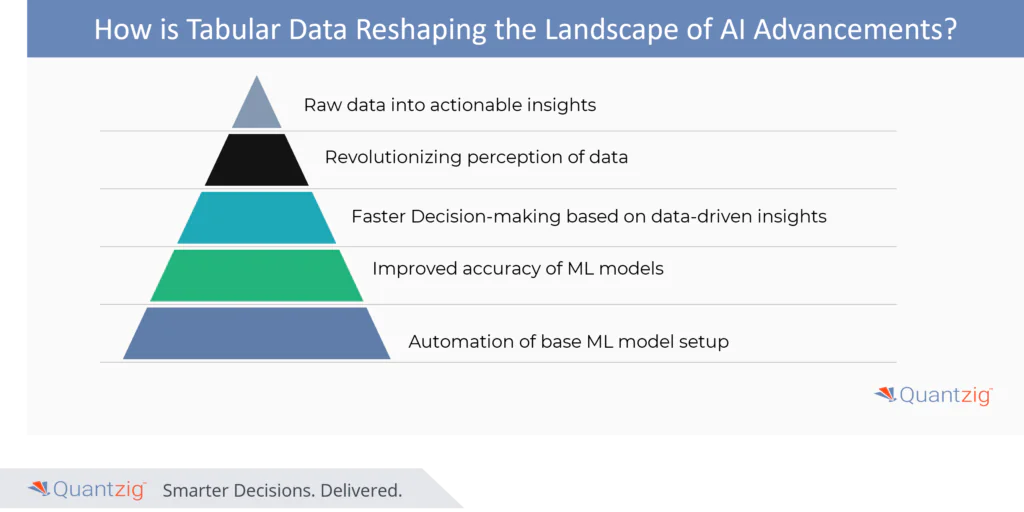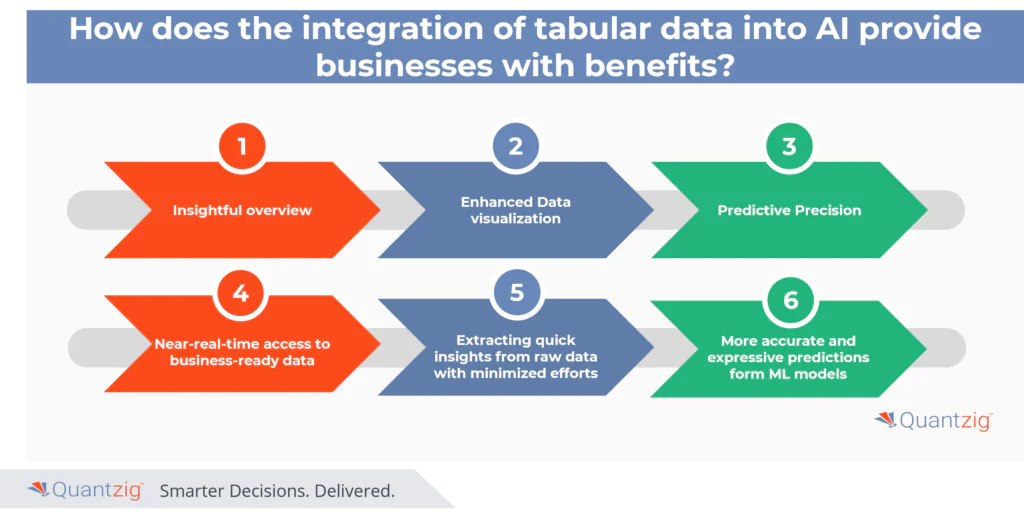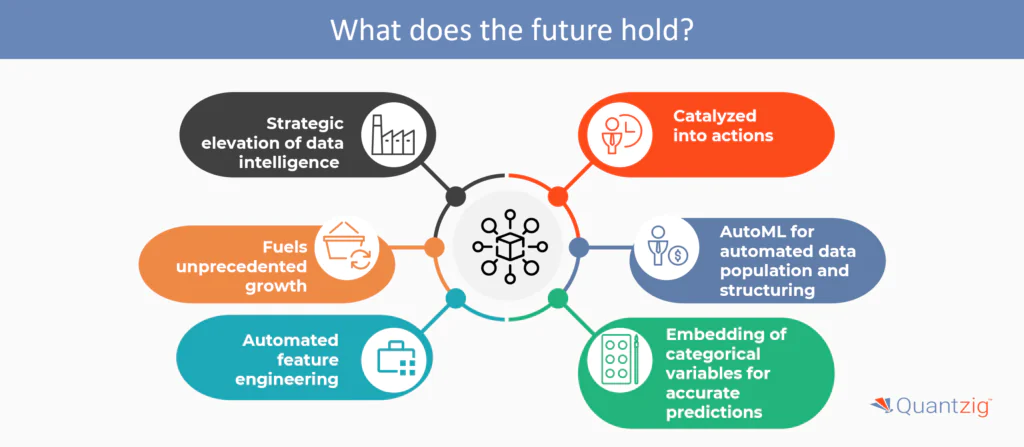Written By: Sudeshna Ghosh
Table of Contents
Introduction to AI for tabular data
In the pursuit of technological advancement, the synergy between artificial intelligence (AI) and tabular data, a structural arrangement of data in rows and columns, has catalyzed an evolutionary leap, reshaping the information processing landscape. Tabular data encompasses everything from spreadsheets and CSV files to relational databases. This transformative convergence not only heralds a new era of data-driven decision-making but also unlocks unprecedented efficiency. As businesses, including digital retailers, vie for supremacy in the fiercely competitive realm of AI, harnessing the power of tabular data becomes paramount. The seamless integration of structured information with cutting-edge algorithms, such as neural networks, empowers businesses to gain a competitive edge, chart a course toward unparalleled success, and navigate complexity in the hyper-competitive and dynamic world of AI.
Book a demo to experience the meaningful insights we derive from data through our artificial intelligence tools and platform capabilities. Schedule a demo today!
Request a Free DemoAI for Tabular Data: A Deep Dive
In the industry innovation, the intersection of artificial intelligence (AI) with tabular data is spearheading a profound transformation, reshaping the landscape of AI advancements. As businesses, including digital retailers, seek to harness the power of structured information, the synergy between AI and tabular data becomes increasingly evident. From understanding customer personas to predicting spending behavior, the integration of machine learning techniques, tabular AI, neural networks and AI for tabular data unlocks unprecedented potential for forecasting and regression analysis.
However, the efficacy of AI models hinges crucially on the quality and cleanliness of data. Thus, the twin challenges of data quality and data cleaning emerge as pivotal focal points in the quest for accurate insights. Leveraging Automated machine learning (AutoML) tools for model training and model evaluation, digital retailers can optimize their strategies by synthesizing diverse datasets through Synthetic Data Generation, including pioneering methodologies like GANs and CTGAN.
Moreover, the emergence of a Data-Centric AI Community underscores the collaborative efforts driving industry innovation in this domain, Digital retailer, Data analysis and fostering a rich ecosystem for knowledge exchange and advancement. Against this backdrop, this paper delves into the transformative potential of tabular data in reshaping the landscape of AI advancements, illuminating the pivotal role it plays in propelling businesses towards unparalleled success in the era of artificial intelligence.
How is Tabular Data Reshaping the Landscape of AI Advancements?

1. Raw data into actionable insights
- In the competitive landscape of artificial intelligence, tabular data spearheads a groundbreaking transformation, converting a large volume of raw data into valuable actionable insights. Leveraging structured data, enterprises gain strategic advantages by transforming their vast datasets into valuable intelligence, positioning them at the forefront of this Artificial Intelligence evolution.
- Through techniques such as Data cleaning and Data analysis, businesses refine their datasets, ensuring data quality and enhancing the efficacy of subsequent processes like Model training and Model evaluation. With the advent of Automated machine learning (AutoML) tools and advanced Machine learning algorithms like Neural networks, the capabilities of Digital retailers in understanding Customer personas and predicting Spending behavior have exponentially grown. Forecasting techniques powered by Regression models provide invaluable insights into market trends and consumer preferences.
- Furthermore, innovative approaches such as Synthetic Data Generation using GANs (Generative Adversarial Networks) and Conditional Tabular Generative Adversarial Networks (CTGANs) are revolutionizing how Data-Centric AI Communities generate diverse datasets for training and testing models. In this landscape, the mastery of tabular data analysis and manipulation stands as a cornerstone for enterprises striving to harness the full potential of Artificial Intelligence.
2. Revolutionizing perception of data
- Tabular data, as a fundamental data type, plays a pivotal role in various aspects of data-driven endeavors, including Vertex AI. Leveraging tabular data within Vertex AI, businesses can unlock powerful insights and streamline their operations. This integration of tabular data with Vertex AI empowers organizations to enhance their email program strategies through advanced supervised machine learning techniques.
- In practical use cases, businesses can employ Vertex AI’s robust features to optimize their email programs, utilizing tabular data to identify patterns and predict customer behavior. By carefully selecting input features and defining the target column, organizations can tailor their email marketing campaigns with precision, ensuring higher engagement and conversion rates.
- Moreover, Vertex AI’s capabilities extend beyond mere data analysis; it facilitates seamless model training and deployment, mitigating challenges such as data leakage and training-serving skew. Through meticulous data preparation and adherence to classification metrics like precision and recall, businesses can refine their email marketing strategies and achieve unprecedented success.
- Incorporating regression metrics and forecasting techniques within Vertex AI enables organizations to anticipate market trends and optimize their email outreach accordingly. This holistic approach not only maximizes the effectiveness of email marketing but also drives overall business growth.
- In conclusion, the synergy between tabular data and Vertex AI revolutionizes the landscape of email marketing, offering unparalleled insights and opportunities for innovation. By embracing this paradigm shift and leveraging advanced model deployment training methods and classification techniques, businesses can stay ahead in the competitive market and redefine their approaches to customer engagement.
3. Faster Decision-making based on data-driven insights
- In the race for swift decision-making, tabular data emerges as a catalyst, enabling businesses to make faster and more informed choices based on data-driven insights. The integration of structured data accelerates decision-making processes, providing a crucial competitive advantage in industries where rapid responses are paramount.
- To achieve such efficiency, businesses often rely on various techniques and tools, including batch prediction and online prediction. These methods, often facilitated through REST API, allow for the quick processing of data and generation of insights in real-time.
- Before implementing deep learning models, proper data management is essential. This includes tasks such as data gathering, data sourcing, data labeling, and ensuring data consistency. Additionally, data formatting plays a significant role in preparing the training dataset, validation dataset, and test dataset for model training and evaluation.
- Once the data is ready, the focus shifts to model development and optimization. Techniques like Generative AI, including VanillaGAN, CGAN, and WGAN-GP, can be employed to enhance model performance. Optimization efforts aim to fine-tune algorithms to better fit the data and improve predictive accuracy.
- In recent years, tools like Python have become instrumental in data science and machine learning workflows. Libraries such as YData, developed by experts like Gonçalo Martins Ribeiro, Data splits, Model optimization, Adult Census Income dataset offer comprehensive solutions for data analysis and modeling tasks.
- In summary, by leveraging structured data, employing efficient prediction techniques, and utilizing advanced modeling approaches, businesses can streamline their decision-making processes and gain a competitive edge in today’s fast-paced markets.
4. Improved accuracy of ML models
- The accuracy of machine learning models takes center stage in the competitive field of AI applications. Tabular data becomes a game-changer, enhancing the reliability and precision of ML models. Businesses gain a significant competitive edge by leveraging tabular data to ensure superior performance and optimize deep learning models in predictive analytics.
- Moreover, leveraging machine learning techniques like Automated machine learning (AutoML) tools for model training and model evaluation enables digital retailers to understand customer personas and spending behavior more accurately. Through data analysis and regression techniques, they can include forecasting future trends and optimize their strategies accordingly. However, achieving accurate predictions requires robust data quality and thorough data cleaning processes.
- To overcome challenges related to data quality and quantity, innovative approaches like Synthetic Data Generation, including the application of GANs (Generative Adversarial Networks) and CTGAN, have emerged. These techniques not only augment the dataset but also enhance its diversity, leading to more robust deep learning models and insights.
- Furthermore, fostering a Data-Centric AI Community facilitates knowledge exchange and collaboration, driving advancements in AI and its applications in various domains, including digital retail. Through continuous innovation and collaboration, businesses can harness the full potential of AI and tabular data to stay ahead in the rapidly evolving landscape of technology and commerce.
5. Automation of base ML model setup
Automation has become a strategic imperative in the competitive landscape of machine learning. Tabular data plays a pivotal role in streamlining workflows, automating the setup of base ML models, and optimizing resources. This automation-driven efficiency becomes a key competitive advantage, allowing businesses to expedite model development and deployment, staying ahead in the dynamic AI environment.
Experience the advantages firsthand by testing a customized complimentary pilot designed to address your specific artificial intelligence requirements. Pilot studies are non-committal in nature.
Request a Free PilotHow Quantzig helps to optimize Tabular Data effectively?
Quantzig partnered with a leading global financial institution which manages vast amounts of tabular data across multiple departments, including customer transactions, account details, and financial records. With an extensive client base and complex data structures, the client faced challenges in optimizing operations and extracting actionable insights from their tabular data. The client encountered several challenges in managing and leveraging their tabular data effectively. These challenges included:
- Data Silos: The client struggled with disparate data sources and siloed systems, leading to inefficiencies in data management and analysis.
- Manual Processes: Their team relied on manual data entry and processing methods, resulting in errors, delays, and increased operational costs.
- Limited Insights: Despite having vast amounts of tabular data, the client lacked the tools and capabilities to derive meaningful insights and drive informed decision-making.
- Scalability Issues: With a growing customer base and expanding operations, they faced scalability challenges in handling and processing large volumes of tabular data efficiently.
Solutions Offered by Quantzig:
Quantzig implemented a comprehensive AI-driven solution tailored to address the client’s specific challenges and requirements. The solutions offered included:
- Data Integration: We developed a unified data integration framework to consolidate and harmonize tabular data from disparate sources, eliminating data silos and streamlining data management processes.
- Automated Data Processing: Leveraging AI and machine learning algorithms, we automated data processing tasks, such as data cleansing, normalization, and enrichment, reducing manual intervention and enhancing data accuracy.
- Advanced Analytics: Quantzig deployed advanced analytics models to analyze tabular data and uncover actionable insights related to customer behavior, financial trends, and risk management, empowering the client to make data-driven decisions.
- Scalable Infrastructure: Our team implemented scalable infrastructure solutions to accommodate the client’s growing data volumes and ensure optimal performance and reliability.
Impact Achieved by Quantzig:

- 2x faster decision-making with intuitive visualizations
- 3x faster decision-making with real-time data availability
- 30% reduced effort to model built prior to decision-making
- 25% increased model accuracy
2 Best areas where your business can put AI for Tabular Data to use:

1. Power of AI-enabled Reporting and alerts:
In the fiercely competitive landscape of artificial intelligence, the transformative ascendancy of tabular data is exemplified by its unparalleled proficiency in fostering AI-enabled alerts and reporting. Organizations gain a decisive competitive edge as they leverage advanced algorithms to generate insightful and real-time reports and alerts. This empowers stakeholders with proactive strategic responsiveness and decision-making capabilities, elevating their capacity to stay ahead in a fast-paced and dynamic business environment.
2. Automated Data Transformation and Intuitive Analytics:
Tabular data’s evolutionary journey into AI heralds an era of automated data transformation and intuitive analytics, setting new benchmarks for precision and efficiency. Businesses achieve a competitive advantage by revolutionizing data processing workflows and embracing AI-driven automation. This not only empowers decision-makers with intuitive analytics but also ensures data accuracy, enabling strategic planning that aligns with the dynamic demands of the professional landscape.
Get started with your complimentary trial today and delve into our platform without any obligations. Explore our wide range of customized, artificial intelligence solutions built across the analytical maturity levels.
Start your free trial now6 Benefits of integrating tabular data into the world of AI

Tabular data is playing a pivotal role in reshaping the landscape of AI advancements, driving innovation across various domains. Leveraging techniques like gradient-boosted tree ensembles and self-supervised learning (SSL), alongside cutting-edge methodologies such as Masked Encoding for Tabular Data (MET) and automated machine learning (AutoML) tools, AI practitioners can extract valuable insights from structured datasets with unprecedented accuracy and efficiency.
1. Insightful overview:
Tabular data’s integration into AI architecture delivers an insightful overview, providing businesses with a comprehensive understanding of their data landscape. This strategic advantage allows for informed decision-making and a competitive edge in navigating complex business scenarios.
2. Enhanced Data visualization:
The evolutionary leap of tabular data in AI is characterized by enhanced data visualization, offering a visually compelling representation of complex datasets. This empowers decision-makers with a competitive advantage, enabling them to derive meaningful insights and communicate data-driven narratives more effectively.
3. Predictive Precision:
Tabular data’s synergy with AI elevates predictive precision, refining machine learning models for unparalleled accuracy. Businesses gain a competitive advantage by making data-driven predictions with a high degree of accuracy, enabling strategic planning and resource optimization.
4. Near-real-time access to business-ready data:
The integration of tabular data into AI ecosystems facilitates near-real-time access to business-ready data, ensuring a competitive edge through timely decision-making. This accelerated access enables businesses to respond swiftly to market dynamics and emerging opportunities.
5. Extracting quick insights from raw data with minimized efforts:
Tabular data’s evolution into AI streamlines the process of extracting quick insights from raw data, minimizing efforts while maximizing efficiency. This efficiency becomes a competitive advantage, allowing organizations to derive valuable insights rapidly and make informed decisions in a dynamic business environment.
6. More accurate and expressive predictions form ML models:
Leveraging tabular data in AI results in more accurate and expressive predictions from machine learning models. This accuracy becomes a competitive differentiator, empowering businesses to make informed decisions based on reliable predictions, ultimately enhancing overall operational effectiveness.
With the emergence of explainable AI (XAI), decision-makers can now understand and interpret the underlying mechanisms of AI models, fostering trust and transparency in data-driven decision-making processes. From LaMDA and GPT-3 in natural language processing to computer vision (CV) models, tabular data serves as a foundational component for training and refining these advanced AI algorithms, enabling breakthroughs in data science and empowering organizations to unlock the full potential of AI across diverse applications and industries.
generative AI for tabular data: The Future

1. Strategic elevation of data intelligence
The future unfolds with the strategic elevation of data intelligence, where the fusion of ai tabular data and AI technologies reshapes industries. This paradigm shift with generative ai for tabular data enhances decision-making capabilities, providing businesses with a competitive advantage through insightful analytics and data-driven strategies.
2. Catalyzed into actions
The convergence of tabular data and AI not only envisions the future but catalyzes actionable outcomes. This transformative synergy of ai tabular data propels businesses beyond analysis paralysis, ensuring that insights are swiftly translated into strategic actions, offering a competitive edge in dynamic markets.
3. Fuels unprecedented growth
Tabular data’s evolution into the realm of AI fuels unprecedented growth, revolutionizing the scalability and efficiency of operations. Businesses gain a competitive advantage by leveraging this growth catalyst to expand market presence, drive industry innovation, and stay ahead in an ever-evolving business landscape.
4. AutoML for automated data population and structuring
The future landscape sees the integration of Automated machine learning (AutoML) tools, revolutionizing data handling through automated population and structuring. This not only optimizes resource utilization but also positions businesses competitively by streamlining the data preparation process for machine learning applications.
5. Automated feature engineering without explicit human intervention
Tabular data’s evolution foresees automated feature engineering without explicit human intervention, a game-changer in model optimization. This automated refinement process ensures more efficient and competitive machine learning models, driving predictive accuracy and strategic advantage.
6. Embedding of categorical variables for more accurate predictions
The future unfolds with the embedding of categorical variables, enhancing the accuracy of predictions. This refined approach in AI-driven models provides businesses with a competitive edge by enabling more precise decision-making and forecasting in diverse and dynamic scenarios.
tabular data vs non tabular data
Let’s compare tabular data and non-tabular data to see the differences that it brings into the table:
| Aspect | Tabular Data | Non-Tabular Data (Unstructured Data) |
|---|---|---|
| Definition | Structured data organized into rows and columns. | Data that lacks a predefined structure. |
| Examples | Databases, spreadsheets, CSV files. | Text documents, images, audio, video, etc. |
| Format | Consistent format with fixed columns and data types. | Varied formats, often without a clear structure. |
| Storage | Stored in tables with rows and columns. | No fixed schema; stored as-is. |
| Querying | Easily queried using SQL or other query languages. | Complex to query; requires specialized tools. |
| Schema | Has a defined schema (column names, data types). | No strict schema; flexible and adaptable. |
| Processing | Well-suited for analytics, reporting, and joins. | Requires preprocessing for analysis. |
| Examples of Use | Sales transactions, customer records, inventory. | Social media posts, sensor data, emails. |
Remember that tabular data is highly structured, making it suitable for databases and analytical tasks. Non-tabular data, on the other hand, is diverse and often requires custom processing to extract meaningful insights.
Conclusion
In conclusion, the symbiotic evolution of tabular data and artificial intelligence heralds a transformative era in data analytics. The strategic elevation of data intelligence, catalyzing actionable insights, fuels unprecedented growth, positioning businesses at the forefront of innovation. The integration of automated feature engineering and AutoML signifies a leap towards efficiency and competitiveness, streamlining processes and optimizing resource utilization. The foresight to embed categorical variables ensures more accurate predictions, enhancing decision-making precision. As industries embrace this evolutionary leap, the future promises a landscape where tabular data becomes a cornerstone for data-driven, agile strategies, propelling organizations toward unparalleled success in the dynamic realm of artificial intelligence.



